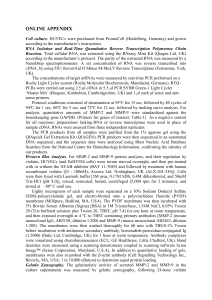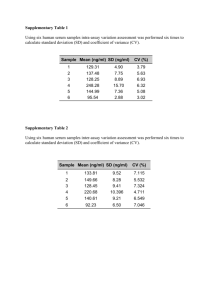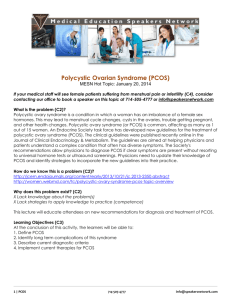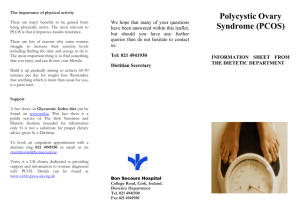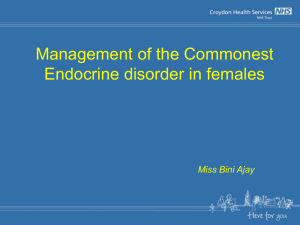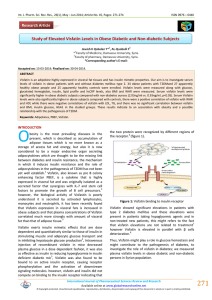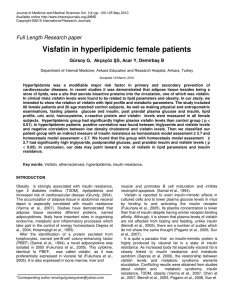Document 13309321
advertisement
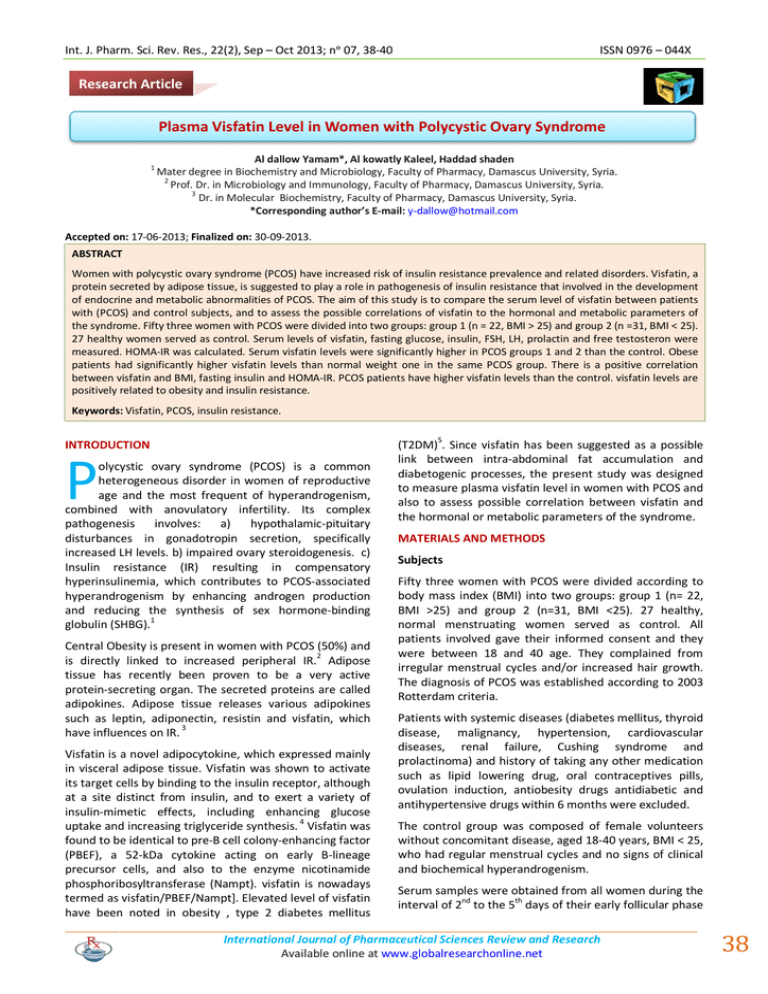
Int. J. Pharm. Sci. Rev. Res., 22(2), Sep – Oct 2013; nᵒ 07, 38-40 ISSN 0976 – 044X Research Article Plasma Visfatin Level in Women with Polycystic Ovary Syndrome 1 Al dallow Yamam*, Al kowatly Kaleel, Haddad shaden Mater degree in Biochemistry and Microbiology, Faculty of Pharmacy, Damascus University, Syria. 2 Prof. Dr. in Microbiology and Immunology, Faculty of Pharmacy, Damascus University, Syria. 3 Dr. in Molecular Biochemistry, Faculty of Pharmacy, Damascus University, Syria. *Corresponding author’s E-mail: y-dallow@hotmail.com Accepted on: 17-06-2013; Finalized on: 30-09-2013. ABSTRACT Women with polycystic ovary syndrome (PCOS) have increased risk of insulin resistance prevalence and related disorders. Visfatin, a protein secreted by adipose tissue, is suggested to play a role in pathogenesis of insulin resistance that involved in the development of endocrine and metabolic abnormalities of PCOS. The aim of this study is to compare the serum level of visfatin between patients with (PCOS) and control subjects, and to assess the possible correlations of visfatin to the hormonal and metabolic parameters of the syndrome. Fifty three women with PCOS were divided into two groups: group 1 (n = 22, BMI > 25) and group 2 (n =31, BMI < 25). 27 healthy women served as control. Serum levels of visfatin, fasting glucose, insulin, FSH, LH, prolactin and free testosteron were measured. HOMA-IR was calculated. Serum visfatin levels were significantly higher in PCOS groups 1 and 2 than the control. Obese patients had significantly higher visfatin levels than normal weight one in the same PCOS group. There is a positive correlation between visfatin and BMI, fasting insulin and HOMA-IR. PCOS patients have higher visfatin levels than the control. visfatin levels are positively related to obesity and insulin resistance. Keywords: Visfatin, PCOS, insulin resistance. INTRODUCTION P olycystic ovary syndrome (PCOS) is a common heterogeneous disorder in women of reproductive age and the most frequent of hyperandrogenism, combined with anovulatory infertility. Its complex pathogenesis involves: a) hypothalamic-pituitary disturbances in gonadotropin secretion, specifically increased LH levels. b) impaired ovary steroidogenesis. c) Insulin resistance (IR) resulting in compensatory hyperinsulinemia, which contributes to PCOS-associated hyperandrogenism by enhancing androgen production and reducing the synthesis of sex hormone-binding globulin (SHBG).1 Central Obesity is present in women with PCOS (50%) and is directly linked to increased peripheral IR.2 Adipose tissue has recently been proven to be a very active protein-secreting organ. The secreted proteins are called adipokines. Adipose tissue releases various adipokines such as leptin, adiponectin, resistin and visfatin, which have influences on IR. 3 Visfatin is a novel adipocytokine, which expressed mainly in visceral adipose tissue. Visfatin was shown to activate its target cells by binding to the insulin receptor, although at a site distinct from insulin, and to exert a variety of insulin-mimetic effects, including enhancing glucose uptake and increasing triglyceride synthesis. 4 Visfatin was found to be identical to pre-B cell colony-enhancing factor (PBEF), a 52-kDa cytokine acting on early B-lineage precursor cells, and also to the enzyme nicotinamide phosphoribosyltransferase (Nampt). visfatin is nowadays termed as visfatin/PBEF/Nampt]. Elevated level of visfatin have been noted in obesity , type 2 diabetes mellitus (T2DM)5. Since visfatin has been suggested as a possible link between intra-abdominal fat accumulation and diabetogenic processes, the present study was designed to measure plasma visfatin level in women with PCOS and also to assess possible correlation between visfatin and the hormonal or metabolic parameters of the syndrome. MATERIALS AND METHODS Subjects Fifty three women with PCOS were divided according to body mass index (BMI) into two groups: group 1 (n= 22, BMI >25) and group 2 (n=31, BMI <25). 27 healthy, normal menstruating women served as control. All patients involved gave their informed consent and they were between 18 and 40 age. They complained from irregular menstrual cycles and/or increased hair growth. The diagnosis of PCOS was established according to 2003 Rotterdam criteria. Patients with systemic diseases (diabetes mellitus, thyroid disease, malignancy, hypertension, cardiovascular diseases, renal failure, Cushing syndrome and prolactinoma) and history of taking any other medication such as lipid lowering drug, oral contraceptives pills, ovulation induction, antiobesity drugs antidiabetic and antihypertensive drugs within 6 months were excluded. The control group was composed of female volunteers without concomitant disease, aged 18-40 years, BMI < 25, who had regular menstrual cycles and no signs of clinical and biochemical hyperandrogenism. Serum samples were obtained from all women during the interval of 2nd to the 5th days of their early follicular phase International Journal of Pharmaceutical Sciences Review and Research Available online at www.globalresearchonline.net 38 Int. J. Pharm. Sci. Rev. Res., 22(2), Sep – Oct 2013; nᵒ 07, 38-40 of menstrual cycles. Levels of plasma glucose, insulin, FSH, LH, free testosterone, prolactin and visfatin were measured after 8-12 hours fasting. The blood samples were centrifuged at 4000 rpm for 10 min and separated and stored at -80C un l they analyzed except the glucose which measured immediately. BMI and HOMA-IR were calculated. Laboratory analyses ISSN 0976 – 044X ng/ml, p < 0.0001). Also Serum visfatin levels were significantly higher in PCOS groups 2 than the control (8.66 ng/ml versus 6.72 ng/ml, p = 0.0004). There is a significant difference in visfatin levels between group 1 and 2 in the same PCOS patients (p= 0.006). There is a positive correlation between visfatin and BMI, insulin and HOMA-IR (table 2). Table 1: clinical characteristics of the study group Insulin, FSH, LH and prolactin were measured by electrochemiluminescence immunoassay method with elecsys analyser (Roche Diagnostics, Germany). Free testosteron was measured by Competitive immunoenzymatic colorimetric method (Dia metra). Visfatin was measured by Enzyme-linked immunosorbant assay (ELISA) using (ADIPO BIOSCIENCE. USA) kit. Finally plasma glucose was measured with the glucose oxidase method on an auto analyzer (Hitachi, Roche Diagnostics, Germany.) IR was determined by homeostasis model assessment (HOMA) using this formula: fasting insulin (µIU/ml) x fasting glucose (mg/dl) / 405. Statistical Analysis Control N= 27 PCOS (BMI>25) N = 22 PCOS (BMI<25) N = 31 BMI ( kg/m2) 22.18±2.8 29.44±3.4*‡ 21.1±1.72 Age (years) 30.23±5.6 25.6±4.8 24.3±5.7 visfatin (ng/ml) 6.72±1.76 10.86±3.04*‡ 8.66±2.15* Fasting glucose (mg/dl) 83.5±8.13 90.14±8.59* 87.48±10.18 Fasting insulin (µU/ml) 7.22±3.82 12.55±3.11*‡ 9.08±3.54 HOMA-IR 1.51±0.84 2.8±0.78*‡ 1.98±0.83* FSH ( mIU/ml) 6.73±1.83 6.16±1.68 6.23±1.29 LH (mIU/ml) The Statistical Package for the Social Science (SPSS) version 16.0 and Microsoft Office Excel 2007 were used for statistical analysis. Results were expressed as mean± S.D. The clinical and laboratory characteristics in the two groups were compared by the student t-test. For all analysis, P- value less than < 0.05 was considered statistically significant. Bivariate correlation analysis (calculation of the Person coefficient) was used to assess the correlation of serum visfatin levels to each parameter. 5.4±1.88 9.46±6.77* 8.26±4.98* Prolactin (ng/ml) 17.91±7.91 25.27±29.1 20.76±13.4 Free testosteron (pg/ml) 1.43±1.1 4.34±3.03*‡ 2.33±1.65* (mean±SD)*P < 0.05 vs control, ‡ p< 0.05 vs PCOS (BMI <25) Table 2: positive correlation between visfatin and these parameters in PCOS group Parameters R P value BMI 0.32 0.01 Fasting insulin 0.31 0.01 HOMA-IR 0.34 0.005 RESULTS AND DISCUSSION Results Patients group was divided according to body mass index (BMI) into two groups: group 1 (n= 22, BMI >25) and group 2 (n=31, BMI <25). The control group consisted of 27 healthy women (BMI <25). Basic hormonal and metabolic features of the women studied are summarized in table 1. Group 1 (over-weight and obese patients) had a significantly higher BMI than normal weight women with or without PCOS. Fasting glucose levels were significantly higher in group 1 than the control (p = 0.006). Fasting insulin levels was significantly higher in group 1 than both the control and group 2, (p < 0.0001), (p = 0.0004) respectively. Fasting insulin levels was higher in group 2 than the control but did not reach statistical significance (p = 0.057). HOMA-IR was significantly higher in PCOS groups 1and 2 than the control, (p< 0.0001) and (p= 0.04) respectively. Also, there is a significant difference in HOMA-IR between group 1 and 2 in the same PCOS patients (p= 0.0005). As expected, the levels of LH and free testosteron were significantly higher in PCOS groups 1and 2 than the control which convenient to the pathophysiology of PCOS. Serum visfatin levels were significantly higher in PCOS groups 1 than the control (10.86 ng/ml versus 6.72 PCOS group n= 53 Discussion PCOS is characterized by chronic anovulation, hyperandrogenism, central obesity and insulin resistance, and it is probably the most common endocrine disorder in 1 women of reproductive age. The results we obtained with regard to the basic hormonal profile of women with PCOS, compared to the control, are in concordance with well established evidence on the fundamental characteristics of the syndrome. In the present study, viafatin levels were found to be significantly elevated in normal weight women with PCOS compared to BMI matched control similar to most studies. 6-8 High visfatin levels may suggest an impaired mechanism of visfatin signaling in target tissues in state of insulin resistance. Moreover, these finding could reflect a compensatory response to tissue-specific IR and hyperinsulinemia or an intrinsic dysregulation in visfatin biosynthesis. International Journal of Pharmaceutical Sciences Review and Research Available online at www.globalresearchonline.net 39 Int. J. Pharm. Sci. Rev. Res., 22(2), Sep – Oct 2013; nᵒ 07, 38-40 Visfatine was significantly higher in overweight-obese PCOS patients than normal weight PCOS patients, this is explained from the positive correlation between visfatin and indices of obesity (BMI), which was shown in other 9,10 studies. These finding because that visfatin and another adipokines are secreted from adipose tissue and visfatin specifically is secreted from visceral adipose tissue more than subcutaneous one, so increased visceral adipose tissue is associated with increased production of visfatin and other adipokines (except adiponectin). 11 Controversial results obtained in the studies investigating relationship between visfatin and insulin resistance. Our study demonstrated a positive correlation between visfatin levels and both, fasting insulin and HOMA-IR. This 8,10 is similar to other studies. This finding suggests that visfatin may be related to insulin resistance, which has a significant role in the pathophysiology of PCOS. On the other side,6,7 could not demonstrate this relationship. However, none of those studies included overweight or obese patients. ISSN 0976 – 044X 3. Gnacińska M, Malgorzewics S, Stojek M, Lysiak-Szydlowska W, Sworczak K, Role of adipokines in complication related to obesity. A Review, Advances in Medical sciences, 54,2009, 150-155. 4. Fukuhra A, Mastuda M, Nishizawa M, Segawa K, Tanaka M, Kishimoto K, Matsuki Y, Murakami M, Ichisaka T, et al. Visfatin: a protein secreted by visceral fat that mimics the effects of insulin, Science, 307, 2005, 426-430 5. peiro̒ C, Romacho T, Carraro R, Sa̒ nchez-Ferrer CF, Visfatin/PBEF/Nampt: A New Cardiovascular Target ?, Frontiers Pharmacology, 1, 2010, 135-142 6. Gen R, Akbay E, Musiu N, Sezer K, Cayan F, Plasma visfatin level in lean women with PCOS: relation to proinflammatory markers and insulin resistance. Gynecological Endocrinology, 25, 2009, 241-245. 7. Panidis D, Farmakiotis D, Rousso D, Katsikis I, Delkos D, Piouka A, Gerou S, Diamanti-Kandarakis E, Plasma visfatin levels in normal weight women with polycystic ovary syndrome, European Journal of Internal Medicine, 19, 2008, 406-412 8. Kowalska I, Strackowski M, Nikalajuk A, Adamska A, Karczewska-Kupczewska M, Otziomek E, wolczynski S, Gorska M, Serum visfatin in relation to insulin resistance and makers of hyperandrogenismin lean and obese women with polycystic ovary syndrome, Human Reproduction, 22, 2007, 1824-1829. 9. Chan TF, Chen YL, Chen HH, Lee CH, Jong SB, Tsai EM, Increased plasma visfatin concentration in women with polycystic ovary syndrome, Fertility and Sterility, 88, 2007, 401-405. Several studies demonstrate that plasma visfatin was related to indicators of hyperandrogenism6,7 but our study and other studies could not determine this relationship. 9-12 CONCLUSION Increase plasma viafatin levels significantly in normal weight and obese women with PCOS compared to control. Visfatin had a positive linear correlation with BMI, fasting insulin and HOMA-IR. These findings suggest that visfatin may be related to obesity and insulin resistance. REFERENCES 1. 2. Khan KA, Stas S, Kurukulasuriya LR, Polycystic Ovarian Syndrome, Journal of the cardiometabolic syndrome, 1, 2006, 125-130. Repaci A, Gambineri A, Pasquali R, The Role of Low-Grade Inflammation in The Polycystic Ovary Syndrome, Molecular and Cellular Endocrinology, 335,2011, 30-41. 10. Dİkmem E, Tarkun İ, Cantürk Z, Çetinarslan B, Plasma visfatin level in women With polycystic ovary syndrome .Gynecological Endocrinology, 27, 2011, 475-479. 11. Tilg H, Moschen AR, Role of adiponectin and PBEF/visfatin as regulators of Inflammation: Involvement in ObesityAssociated Disease. Clinical. Science. 114: 275-288, 2008 12. Jongwutiwes T, Lertvikool S, Leelaphiwat S, Rattanasiri S, Jultanmas R, Weerakiet S, Serum visfatin in Asian women with polycystic ovary syndrome. Gynecological Endocrinology, 25, 2009, 536-542. Source of Support: Nil, Conflict of Interest: None. International Journal of Pharmaceutical Sciences Review and Research Available online at www.globalresearchonline.net 40

